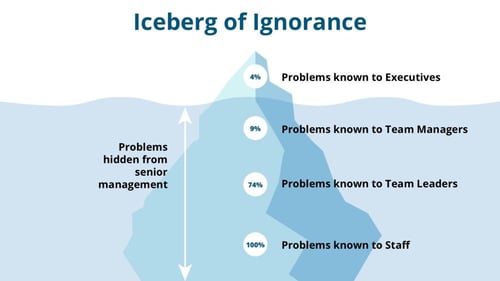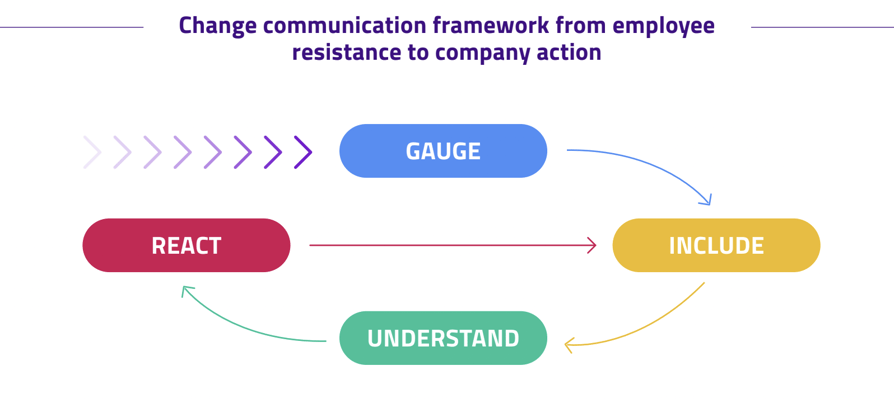What is management communication?
Management communication is just that - managers communicating with their employees. Whether it’s a manager speaking with a department as a whole or one-to-one dialogue, proper, effective communication is a cornerstone of a positive, inclusive workplace culture, and a productive organisation.
In this article you'll learn:
- Why is management communication important?
- How to use management to drive employee experience
- The skills required for management communication
- How to help your managers improve their communication styles
Why is management communication important?
Over the course of three months, employees can be exposed to 2.3 million words and numbers (Adam Grant, host of TED podcast WorkLife). We have more channels to communicate than ever before, but how do we maintain their effectiveness, especially during organisational change? There are plenty of reasons, professional and human, that make effective management communication an absolute must:
It builds change advocacy
In any organisation, small and large-scale change is inevitable, but any change must be communicated effectively if it’s going to stick. According to Gartner, organisations that implement open-source change strategies (i.e. open communication between management and employees) are 14x more likely to experience successful change.
Whatever the planned changes may be, employees need to know why it’s happening, what it means, and that their input is valued. This must be communicated as early as possible in the process - the greater their understanding, the less likely they are to resist the change.
Chris Barrett, Transformation Director at Babble says,"No one ever came out of a transformation programme saying, 'Well, we communicated too much on that one'. There's never too much communication and that starts with the C-suite". Good change management communication is key to bringing your people along the journey with you and making change stick.
It builds connections
The same survey by Gartner found that 82% of employees feel it’s important for their organisation to see them as a person, not just an employee. Two-way communication is the quickest, most reliable route to building strong, authentic connections with staff.
This can have a significant positive impact on the business as a whole: research from Enboarder found that when companies prioritise connections, they’re 2.3 times more likely to have engaged employees and 5.4 times more likely to be agile.
It helps leaders learn
Open communication between management and employees is a two-way learning experience. Just as regular and honest dialogues can help employees understand more about decisions in their organisation, these conversations will help leadership learn more about their employees. These learnings are invaluable - they’ll help management understand the reasons behind change advocacy and resistance, gain a stronger insight into the ‘temperature’ of the workplace, for example.
With Rungway, employees are able to ask questions or raise concerns with the option of anonymity. This surfaces a far more diverse range of voices who can speak up without fear of judgement - normally the 'silent majority'. Leaders can tap into the information they really need to know about, and react much faster.
Sidney Yoshida's Iceberg of Ignorance highlights how little leadership often hear in relation to issues going on within their organisations - only 4%. Businesses must provide a safe space, like Rungway, for employees to flag these issues and ask questions more openly if they want to start hearing what's really beneath the surface.

(Sidney Yoshida)
It closes the gap between management and employees
Without proper, effective communication, it’s almost impossible for there to be any sort of level playing field between employees and leadership. The longer an organisation goes without implementing proper communication practices, the bigger the divide between the two ‘sides’ gets, and the harder it becomes to close.
Open-source communication brings management and employees together and helps to strengthen change advocacy, which increases the likelihood of change being successful. The information and understanding gleaned from open communication will only serve to benefit the organisation in the long term.
How to communicate to drive employee experience
In many organisations, it’s common to communicate via ‘top-down’ management - delivering notices and updates via email without any opportunity for employees to offer their opinions or shape the process in any way.
Open-source change management is the collaborative way of doing things that brings employees to the table and lets them share their views and experiences, and have real input on the process. Using open-source methods helps to drive employee engagement because they feel seen, heard and valued.
Employees should be encouraged to communicate with management. It’s far too easy for management to feel separate from their staff - a study by Fortune found that 54% of employees said they felt ‘voiceless’ - and this feeling causes feelings to be internalised which has a detrimental effect on wellbeing, workplace culture and workplace performance.
If employees are encouraged to come to their managers with questions, concerns, and pain points, they’ll feel more comfortable doing so, and leadership benefits from organic and unprompted bottom-up feedback.
The skills required for management communication
A willingness to hear the negatives
If management communication is truly going to be effective, then leaders must be willing to hear everything from their employees - even the uncomfortable parts. Fielding and understanding employees’ feedback not only helps to inform future decisions and processes, but it also shows that management cares about understanding and finding solutions to employee pain points.
Active listening
Listening is one thing, listening actively is another, more effective one. Truly take on board what your employees are saying - these conversations don’t always have to be about immediate solutions; some people want to know that they’ve been heard and understood. Action plans can be devised after the fact, and those action plans will be better if management has fully understood the issues at hand.
Proactivity
As much as employees should be encouraged to communicate with management, management should also be regularly initiating dialogue with their employees. Again, this shows genuine interest and a willingness to learn. A simple ‘check-in’ can be just as valuable as a more process-driven one-to-one.
Rungway enables leaders and employees to interact directly with each other. If an employee raises a concern on the platform, leadership can respond instantly in a way that's visible to the whole organisation so everyone can benefit. Posts from senior managers get twice the number of click-throughs and can reach up to 96% of employees on the platform.
Punctuality
Punctuality is a key component of effective communication. If an employee wants to open a dialogue with you, it should be done so as early as possible. Push it back unnecessarily and that person may infer that their needs aren’t important to management. If someone requests a conversation, make every effort to hold that conversation at the earliest opportunity.
Adaptability
Implementing new communication methods is unlikely to be an instant success, and it’s likely that you’ll hit bumps as you work to improve management communication. What’s important, then, is being agile; finding what works and improving what doesn’t. Consult with your employees about this, too.
How to help your managers improve their communication styles
However well thought-out your communications are, if they’re being delivered poorly by your managers, the impact will be hampered. Gallagher’s State of the Sector Report found that 41% of internal communication respondents said that poor line manager communication skills were one of the biggest barriers to the success of internal communications in their organisation.
Rungway's four-step method to improving communication and understanding between management and employees is this: Gauge, Include, Understand and React.

Gauge
Effectively gauging the ‘temperature’ of the workplace is the first step to developing the right communication methods. However, many organisations’ methods of gauging temperature are inadequate and ineffective. Consider a biannual survey; they may yield plenty of responses, but these responses are just snapshots from two particular points in time - they don’t show the full story.
It may look on the surface like everything has improved and employees are happy, but in the time between those two surveys, day-to-day experience and satisfaction has faltered, and it hasn’t been picked up by management because they’re using an ineffective tool.
Instead, continually speaking with employees through active, real-time channels will show what’s really going on and help management better understand the experiences of their staff.
Include
Instead of using one or two catch-all methods for speaking to employees, management should go to where their employees are. That might be Slack or a phone conversation, for example. By using channels that employees feel comfortable with, managers will learn more about their employees and hear what people often don’t say in survey responses and in the feedback sections at the end of company conferences.
Managers should also seek to hear from a wider range of voices, not just the regulars. Hearing from the quieter voices provides wider perspective and important insights.
An always-on platform like Rungway, where employees can ask questions and voice their opinions at any hour of the day is the ideal platform for employees and leadership to authentically and organically communicate. Questions and posts can be anonymous, which helps people feel more confident in speaking, and discussions can be visible to all, which means more people can get involved in the conversation.
Understand
Once you have established the best ways to communicate, managers can then dig into their findings - that might be further one-to-one talks with an employee, or it might be using data on people’s day-to-day work experience to analyse practices or plans within the company to see how things could be improved. By this stage managers and leadership should have a comprehensive understanding of the real issues within their organisation, and a clear grasp of areas to prioritise focus.
React
Improved communication will yield considerably more data, and that data will be far more detailed and diverse than it otherwise would have been had your managers used limited communication methods like surveys. With this new data at their disposal, managers can act: implementing changes, engaging with issues and pain points that have surfaced, and continuing the dialogue to show employees that they truly care. Finally, managers understand the reality of what's happening within their organisation, not just a small subset of 'louder voices' and can execute change with far greater impact.
Effective communication between managers and employees underpins so many facets of an organisation; from employee morale and change advocacy to general employee wellbeing and staff retention. Improving the communication at all levels of your business, but particularly between leadership and employees, can help change your organisation for the better.
Rungway is an always-on, always-ready platform for inclusive, effective communication to help companies navigate change. Whether you're looking to improve your culture, go through a people re-structure or transformation programme, Rungway helps you overcome resistance and track project progress through actionable people insights to take your people with you.



.png?width=541&height=700&name=how-to-increase-change-management-success%20(1).png)
